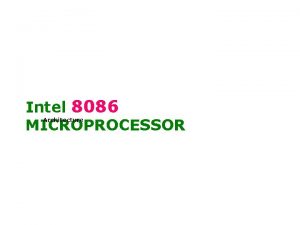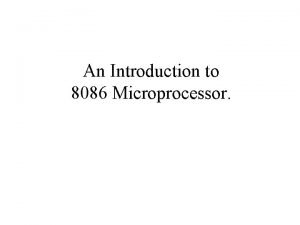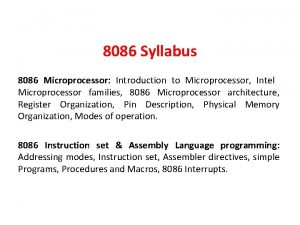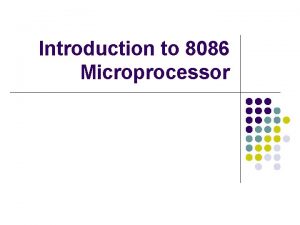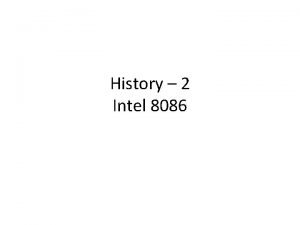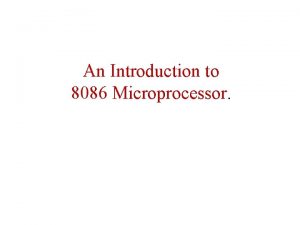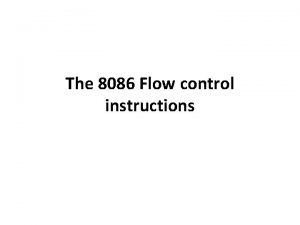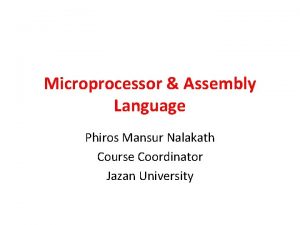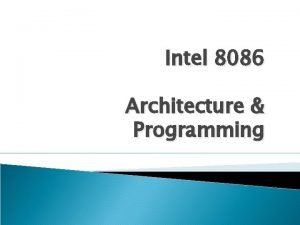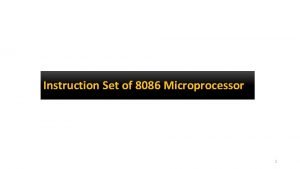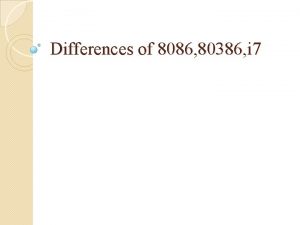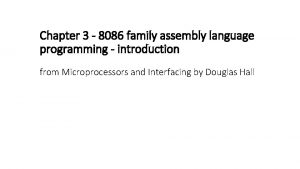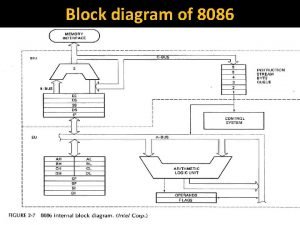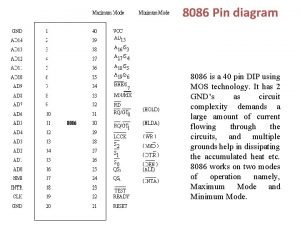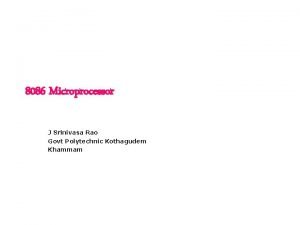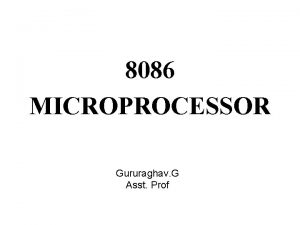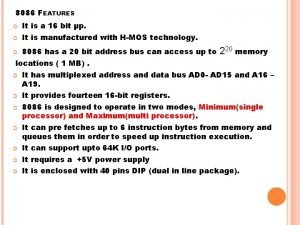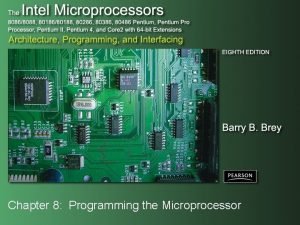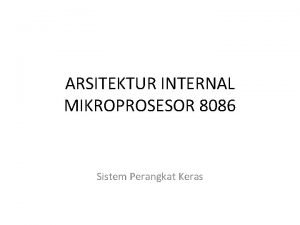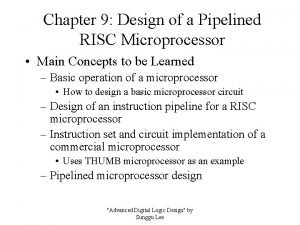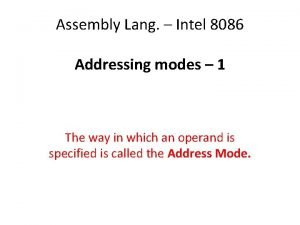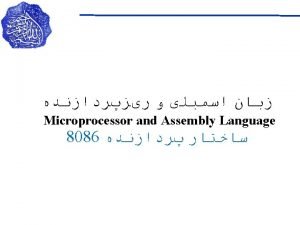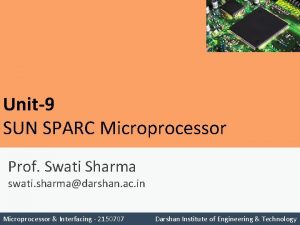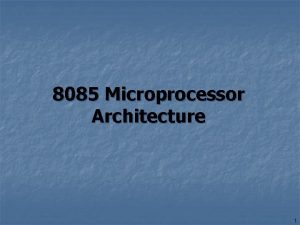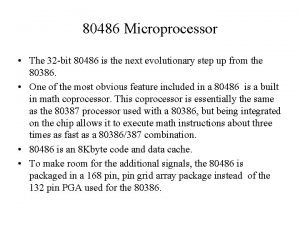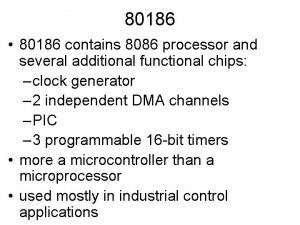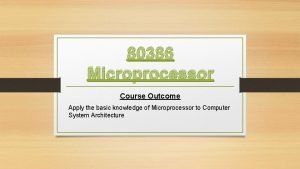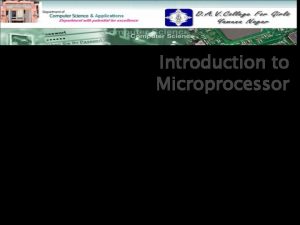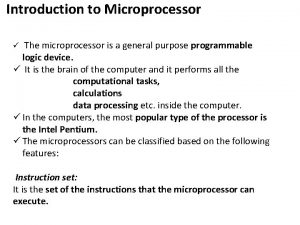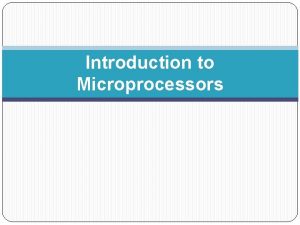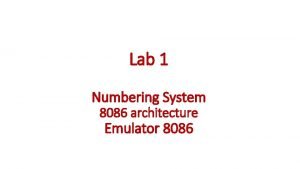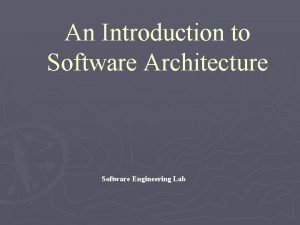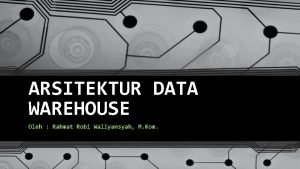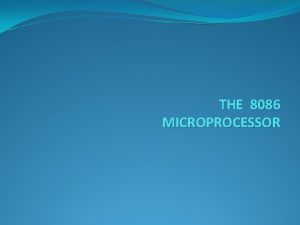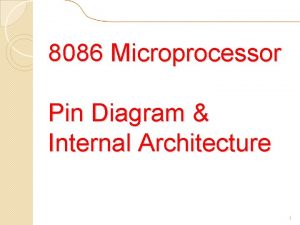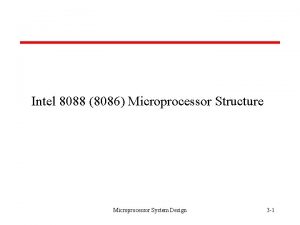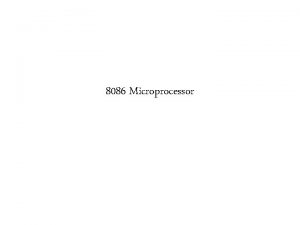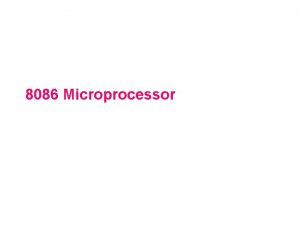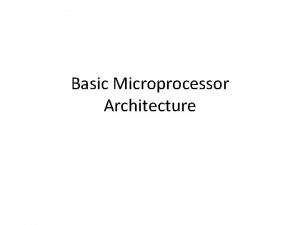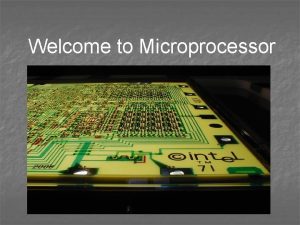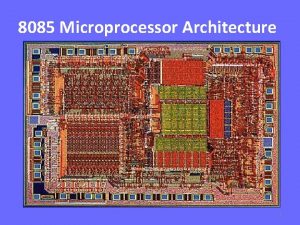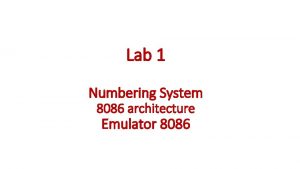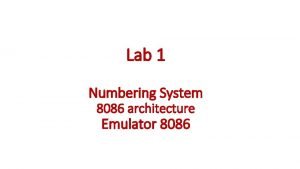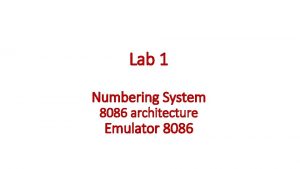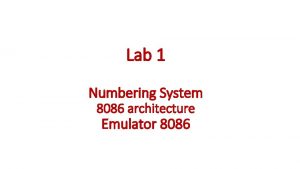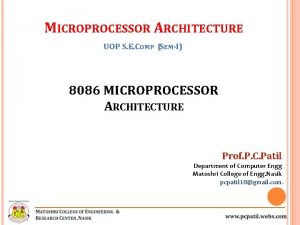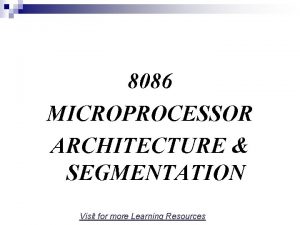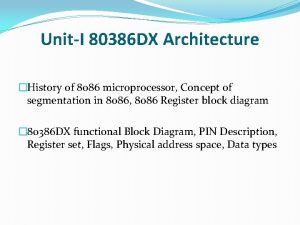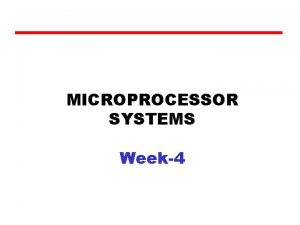Introduction to 8086 Microprocessor Architecture of 8086 l

















































- Slides: 49

Introduction to 8086 Microprocessor

Architecture of 8086 l The architecture of 8086 includes l l l Arithmetic Logic Unit (ALU) Flags General registers Instruction byte queue Segment registers

EU & BIU l l The 8086 CPU logic has been partitioned into two functional units namely Bus Interface Unit (BIU) and Execution Unit (EU) The major reason for this separation is to increase the processing speed of the processor The BIU has to interact with memory and input and output devices in fetching the instructions and data required by the EU EU is responsible for executing the instructions of the programs and to carry out the required processing

EU & BIU

Architecture Diagram

Execution Unit l The Execution Unit (EU) has l l l l Control unit Instruction decoder Arithmetic and Logical Unit (ALU) General registers Flag register Pointers Index registers

Execution Unit l l l Control unit is responsible for the coordination of all other units of the processor ALU performs various arithmetic and logical operations over the data The instruction decoder translates the instructions fetched from the memory into a series of actions that are carried out by the EU

Execution Unit - Registers l l l General registers are used for temporary storage and manipulation of data and instructions Accumulator register consists of two 8 -bit registers AL and AH, which can be combined together and used as a 16 -bit register AX Accumulator can be used for I/O operations and string manipulation

Execution Unit - Registers l l Base register consists of two 8 -bit registers BL and BH, which can be combined together and used as a 16 -bit register BX BX register usually contains a data pointer used for based, based indexed or register indirect addressing Count register consists of two 8 -bit registers CL and CH, which can be combined together and used as a 16 -bit register CX Count register can be used as a counter in string manipulation and shift/rotate instructions

Execution Unit - Registers l l l Data register consists of two 8 -bit registers DL and DH, which can be combined together and used as a 16 -bit register DX Data register can be used as a port number in I/O operations In integer 32 -bit multiply and divide instruction the DX register contains high-order word of the initial or resulting number

Execution Unit - Registers

Execution Unit - Flags

Execution Unit - Flags l l Overflow Flag (OF) - set if the result is too large positive number, or is too small negative number to fit into destination operand Direction Flag (DF) - if set then string manipulation instructions will auto-decrement index registers. If cleared then the index registers will be autoincremented Interrupt-enable Flag (IF) - setting this bit enables maskable interrupts Single-step Flag (TF) - if set then single-step interrupt will occur after the next instruction

Execution Unit - Flags l l l Sign Flag (SF) - set if the most significant bit of the result is set. Zero Flag (ZF) - set if the result is zero. Auxiliary carry Flag (AF) - set if there was a carry from or borrow to bits 0 -3 in the AL register. Parity Flag (PF) - set if parity (the number of "1" bits) in the low-order byte of the result is even. Carry Flag (CF) - set if there was a carry from or borrow to the most significant bit during last result calculation

Execution Unit - Flags

Execution Unit - Pointers l l Stack Pointer (SP) is a 16 -bit register pointing to program stack Base Pointer (BP) is a 16 -bit register pointing to data in stack segment. BP register is usually used for based, based indexed or register indirect addressing. Source Index (SI) is a 16 -bit register. SI is used for indexed, based indexed and register indirect addressing, as well as a source data addresses in string manipulation instructions. Destination Index (DI) is a 16 -bit register. DI is used for indexed, based indexed and register indirect addressing, as well as a destination data addresses in string manipulation instructions.

Execution Unit - Pointers

Bus Interface Unit l The BIU has l l l Instruction stream byte queue A set of segment registers Instruction pointer

BIU – Instruction Byte Queue l l 8086 instructions vary from 1 to 6 bytes Therefore fetch and execution are taking place concurrently in order to improve the performance of the microprocessor The BIU feeds the instruction stream to the execution unit through a 6 byte prefetch queue This prefetch queue can be considered as a form of loosely coupled pipelining

BIU – Instruction Byte Queue l l Execution and decoding of certain instructions do not require the use of buses While such instructions are executed, the BIU fetches up to six instruction bytes for the following instructions (the subsequent instructions) The BIU store these prefetched bytes in a first-in-first out register by name instruction byte queue When the EU is ready for its next instruction, it simply reads the instruction byte(s) for the instruction from the queue in BIU

Segment: Offset Notation l l l The total addressable memory size is 1 MB Most of the processor instructions use 16 -bit pointers the processor can effectively address only 64 KB of memory To access memory outside of 64 KB the CPU uses special segment registers to specify where the code, stack and data 64 KB segments are positioned within 1 MB of memory

Segment: Offset Notation l l l A simple scheme would be to order the bytes in a serial fashion and number them from 0 (or 1) to the end of memory The scheme used in the 8086 is called segmentation Every address has two parts, a SEGMENT and an OFFSET (Segmnet: Offset ) The segment indicates the starting of a 64 kilobyte portion of memory, in multiples of 16 The offset indicates the position within the 64 k portion Absolute address = (segment * 16) + offset

Segment Registers l The memory of 8086 is divided into 4 segments namely l l Code segment (program memory) Data segment (data memory) Stack memory (stack segment) Extra memory (extra segment)

Different Areas in Memory l l Program memory – Program can be located anywhere in memory Data memory – The processor can access data in any one out of 4 available segments Stack memory – A stack is a section of the memory set aside to store addresses and data while a subprogram executes Extra segment – This segment is also similar to data memory where additional data may be stored and maintained

Segment Registers l l Code Segment (CS) register is a 16 -bit register containing address of 64 KB segment with processor instructions The processor uses CS segment for all accesses to instructions referenced by instruction pointer (IP) register Stack Segment (SS) register is a 16 -bit register containing address of 64 KB segment with program stack By default, the processor assumes that all data referenced by the stack pointer (SP) and base pointer (BP) registers is located in the stack segment

Segment Registers l l Data Segment (DS) register is a 16 -bit register containing address of 64 KB segment with program data By default, the processor assumes that all data referenced by general registers (AX, BX, CX, DX) and index register (SI, DI) is located in the data segment Extra Segment (ES) register is a 16 -bit register containing address of 64 KB segment, usually with program data By default, the processor assumes that the DI register references the ES segment in string manipulation instructions

Segment Registers

Pin Diagram

Addressing Modes l l Implied Addressing – The data value/data address is implicitly associated with the instruction Register Addressing – The data is specified by referring the register or the register pair in which the data is present Immediate Addressing – The data itself is provided in the instruction Direct Addressing – The instruction operand specifies the memory address where data is located

Addressing Modes l l l Register indirect addressing – The instruction specifies a register containing an address, where data is located Based - 8 -bit or 16 -bit instruction operand is added to the contents of a base register (BX or BP), the resulting value is a pointer to location where data resides Indexed - 8 -bit or 16 -bit instruction operand is added to the contents of an index register (SI or DI), the resulting value is a pointer to location where data resides

Addressing Modes l l Based Indexed - the contents of a base register (BX or BP) is added to the contents of an index register (SI or DI), the resulting value is a pointer to location where data resides Based Indexed with displacement - 8 -bit or 16 -bit instruction operand is added to the contents of a base register (BX or BP) and index register (SI or DI), the resulting value is a pointer to location where data resides

Data Transfer Instructions

Data Transfer Instructions

Arithmetic Instructions

Arithmetic Instructions

Number Representation

Logical Instructions

String Instructions

Program Transfer Instructions

Program Transfer Instructions

Processor Control Instructions

Assembler Directives l l l Assembler directives give instruction to the assembler where as other instructions discussed in the above section give instruction to the 8086 microprocessor Assembler directives are specific for a particular assembler However all the popular assemblers like the Intel 8086 macro assembler, the turbo assembler and the IBM macro assembler use common assembler directives

Important Directives l l The ASSUME directive tell the assembler the name of the logical segment it should use for a specified segment The DB directive is used to declare a byte-type variable or to set aside one or more storage locations of type byte in memory (Define Byte) The DD directive is used to declare a variable of type doubleword or to reserve memory locations which can be accessed as type doubleword (Define Doubleword) The DQ directive is used to tell the assembler to declare a variable 4 words in length or to reverse 4 words of storage in memory (Define Quadword)

Important Directives l l The ENDS directive is used with the name of a segment to indicate the end of that logical segment The EQU is used to give a name to some value or symbol

Assembly Language Program l l Writing assembly language programs for 8086 is slightly different from that of writing assembly language programs for 8085 In addition to the instructions that are meant for solving the problem, some additional instructions are required to complete the programs The purpose of these additional programs is to initialize various parts of the system, such as segment registers, flags and programmable port devices Some of the instructions are to handle the stack of the 8086 based system

Assembly Language Program l l l Another purpose of these additional instructions is to handle the programmable peripheral devices such as ports, timers and controllers The programmable peripheral interfaces should be assigned suitable control words to make them to function in the way as we expect The best way to approach the initialization task is to make a checklist of all the registers, programmable devices and flags in the system we are working on

Assembly Language Program l An 8086 assembly language program has five columns namely l l l Address Data or code Labels Mmnemonics Operands Comments

Assembly Language Program l l The address column is used for the address or the offset of a code byte or a data byte The actual code bytes or data bytes are put in the data or code column A label is a name which represents an address referred to in a jump or call instruction Labels are put in the labels column

Assembly Language Program l l The operands column contains the registers, memory locations or data acted upon by the instructions A comments column gives space to describe the function of the instruction for future reference
 8086 segment registers
8086 segment registers How to calculate offset address
How to calculate offset address 8086 architecture
8086 architecture Introduction to 8086
Introduction to 8086 8088 block diagram
8088 block diagram 8086 microprocessor architecture
8086 microprocessor architecture Introduction of 8086 microprocessor
Introduction of 8086 microprocessor Addressing modes of 8086 microprocessor
Addressing modes of 8086 microprocessor Cmp instruction in microprocessor
Cmp instruction in microprocessor Input signals in 8086 microprocessor
Input signals in 8086 microprocessor Accumulator function cpu
Accumulator function cpu Features of 8086 microprocessor
Features of 8086 microprocessor Jc 2000h , jump takes place when cy=0 cy=1 zf=0 zf=1
Jc 2000h , jump takes place when cy=0 cy=1 zf=0 zf=1 Difference between 8086 and 80386
Difference between 8086 and 80386 Program development steps in 8086 microprocessor
Program development steps in 8086 microprocessor Block diagram of 8086
Block diagram of 8086 8086 pin description
8086 pin description Rep instruction in 8086
Rep instruction in 8086 8086 microprocessor
8086 microprocessor 8086 microprocessor
8086 microprocessor Intrasegment direct addressing mode
Intrasegment direct addressing mode What is modular programming in microprocessor
What is modular programming in microprocessor What is assembler directives in 8086 microprocessor
What is assembler directives in 8086 microprocessor Gambar arsitektur mikroprosesor
Gambar arsitektur mikroprosesor What is timing diagram in microprocessor
What is timing diagram in microprocessor Pipelining in 8086 microprocessor
Pipelining in 8086 microprocessor Based addressing mode in 8086
Based addressing mode in 8086 80*86
80*86 Highest priority interrupt in 8085
Highest priority interrupt in 8085 Swati sun
Swati sun Block diagram of microprocessor 8085
Block diagram of microprocessor 8085 Block diagram of 80486 microprocessor
Block diagram of 80486 microprocessor 8086 vs 80186
8086 vs 80186 80286 microprocessor architecture
80286 microprocessor architecture 8085 architecture
8085 architecture 80386 registers
80386 registers Microprocessor presentation topics
Microprocessor presentation topics Register organization of 8086
Register organization of 8086 Introduction to microprocessor
Introduction to microprocessor Emulator 8086
Emulator 8086 Mode d'adressage microprocesseur 8086
Mode d'adressage microprocesseur 8086 Architecture business cycle activities
Architecture business cycle activities Data centered architecture
Data centered architecture Integral architecture example
Integral architecture example Modular product architecture
Modular product architecture Bus design in computer architecture
Bus design in computer architecture Introduction to computer organization and architecture
Introduction to computer organization and architecture Conceptual integrity in software architecture
Conceptual integrity in software architecture Enterprise architecture principles
Enterprise architecture principles Komponen data warehouse
Komponen data warehouse
